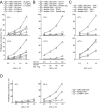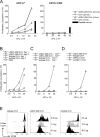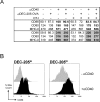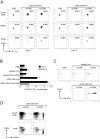Efficient targeting of protein antigen to the dendritic cell receptor DEC-205 in the steady state leads to antigen presentation on major histocompatibility complex class I products and peripheral CD8+ T cell tolerance
- PMID: 12486105
- PMCID: PMC2196060
- DOI: 10.1084/jem.20021598
Efficient targeting of protein antigen to the dendritic cell receptor DEC-205 in the steady state leads to antigen presentation on major histocompatibility complex class I products and peripheral CD8+ T cell tolerance
Abstract
To identify endocytic receptors that allow dendritic cells (DCs) to capture and present antigens on major histocompatibility complex (MHC) class I products in vivo, we evaluated DEC-205, which is abundant on DCs in lymphoid tissues. Ovalbumin (OVA) protein, when chemically coupled to monoclonal alphaDEC-205 antibody, was presented by CD11c+ lymph node DCs, but not by CD11c- cells, to OVA-specific, CD4+ and CD8+ T cells. Receptor-mediated presentation was at least 400 times more efficient than unconjugated OVA and, for MHC class I, the DCs had to express transporter of antigenic peptides (TAP) transporters. When alphaDEC-205:OVA was injected subcutaneously, OVA protein was identified over a 4-48 h period in DCs, primarily in the lymph nodes draining the injection site. In vivo, the OVA protein was selectively presented by DCs to TCR transgenic CD8+ cells, again at least 400 times more effectively than soluble OVA and in a TAP-dependent fashion. Targeting of alphaDEC-205:OVA to DCs in the steady state initially induced 4-7 cycles of T cell division, but the T cells were then deleted and the mice became specifically unresponsive to rechallenge with OVA in complete Freund's adjuvant. In contrast, simultaneous delivery of a DC maturation stimulus via CD40, together with alphaDEC-205:OVA, induced strong immunity. The CD8+ T cells responding in the presence of agonistic alphaCD40 antibody produced large amounts of interleukin 2 and interferon gamma, acquired cytolytic function in vivo, emigrated in large numbers to the lung, and responded vigorously to OVA rechallenge. Therefore, DEC-205 provides an efficient receptor-based mechanism for DCs to process proteins for MHC class I presentation in vivo, leading to tolerance in the steady state and immunity after DC maturation.
Figures







References
-
- Kappler, J.W., N. Roehm, and P. Marrack. 1987. T cell tolerance by clonal elimination in the thymus. Cell. 49:273–280. - PubMed
-
- Kisielow, P., H. Bluthmann, U.D. Staerz, M. Steinmetz, and H. von Boehmer. 1988. Tolerance in T-cell-receptor transgenic mice involves deletion of nonmature CD4+8+ thymocytes. Nature. 333:742–746. - PubMed
-
- Bouneaud, C., P. Kourilsky, and P. Bousso. 2000. Impact of negative selection on the T cell repertoire reactive to a self-peptide: a large fraction of T cell clones escapes clonal detection. Immunity. 13:829–840. - PubMed
-
- Matzinger, P., and S. Guerder. 1989. Does T-cell tolerance require a dedicated antigen-presenting cell? Nature. 338:74–76. - PubMed
Publication types
MeSH terms
Substances
Grants and funding
LinkOut - more resources
Full Text Sources
Other Literature Sources
Research Materials
Miscellaneous

